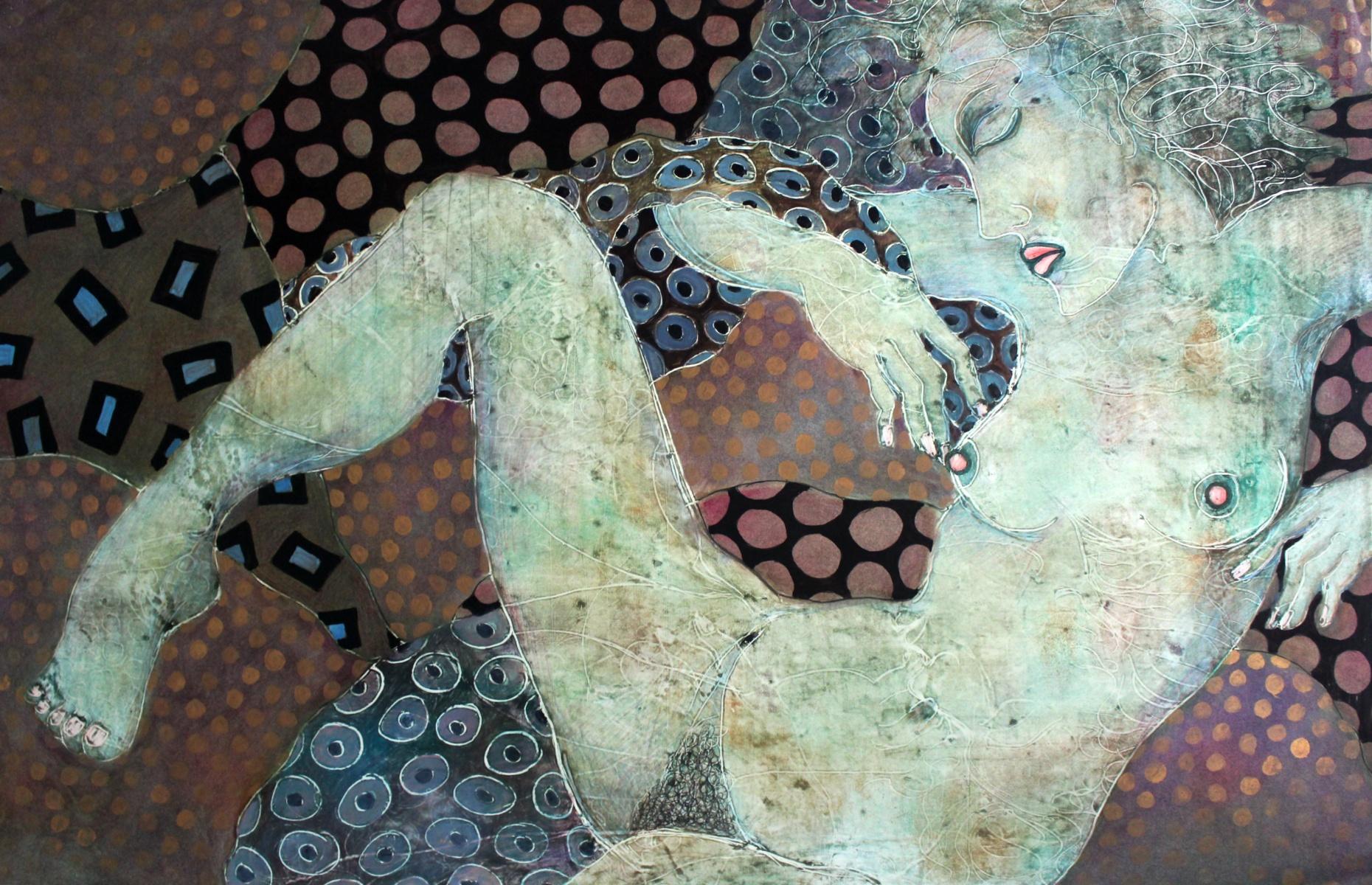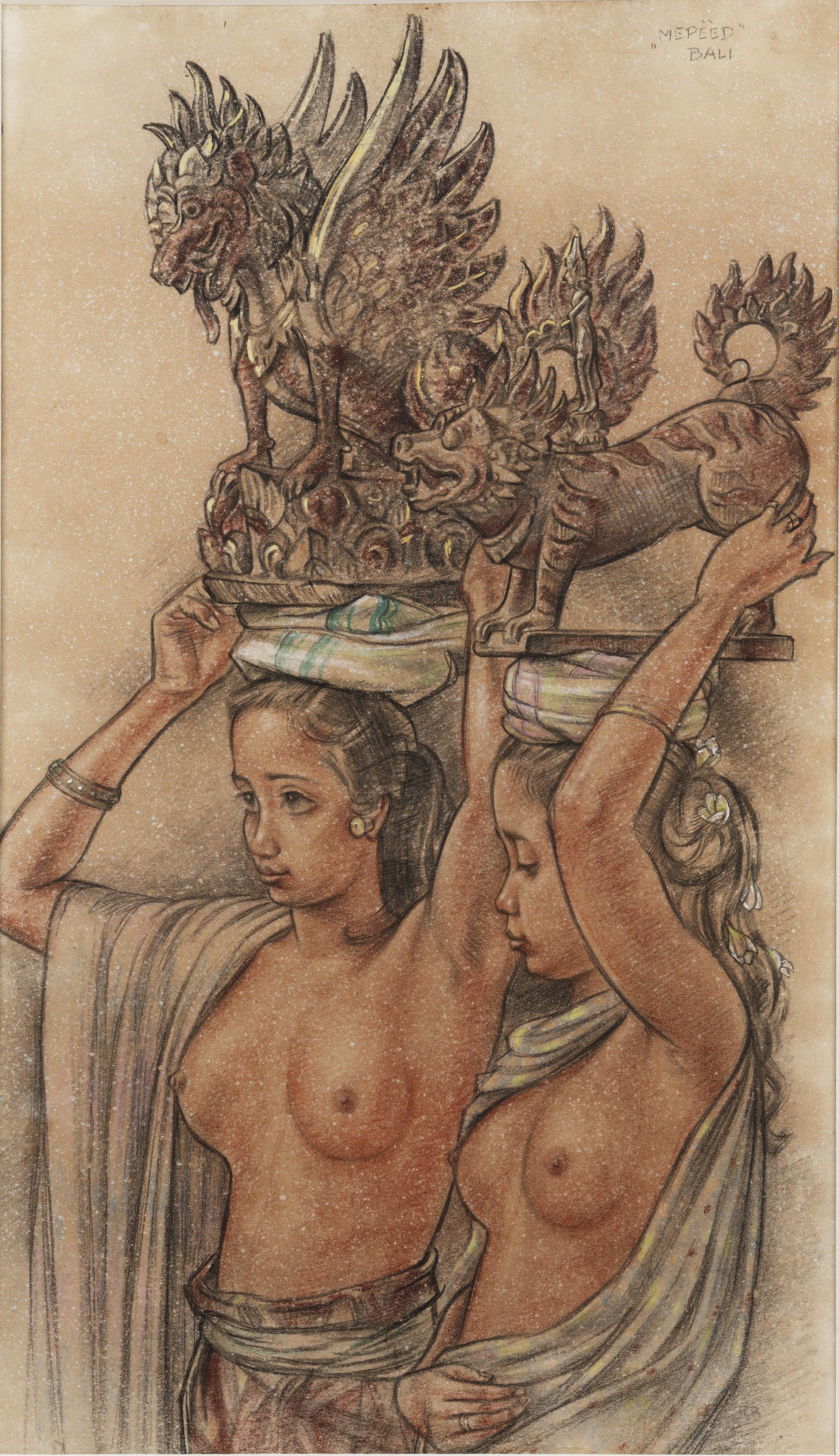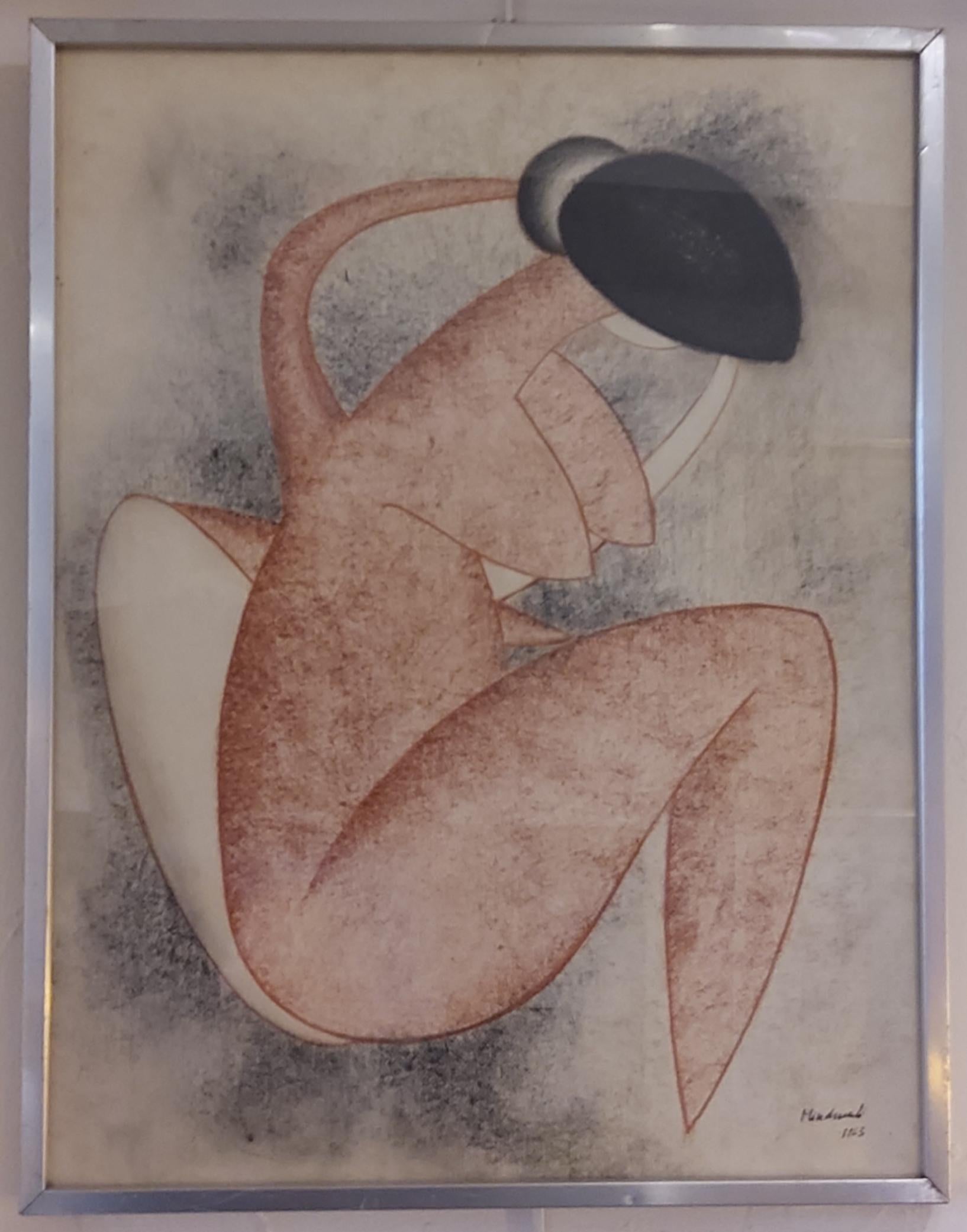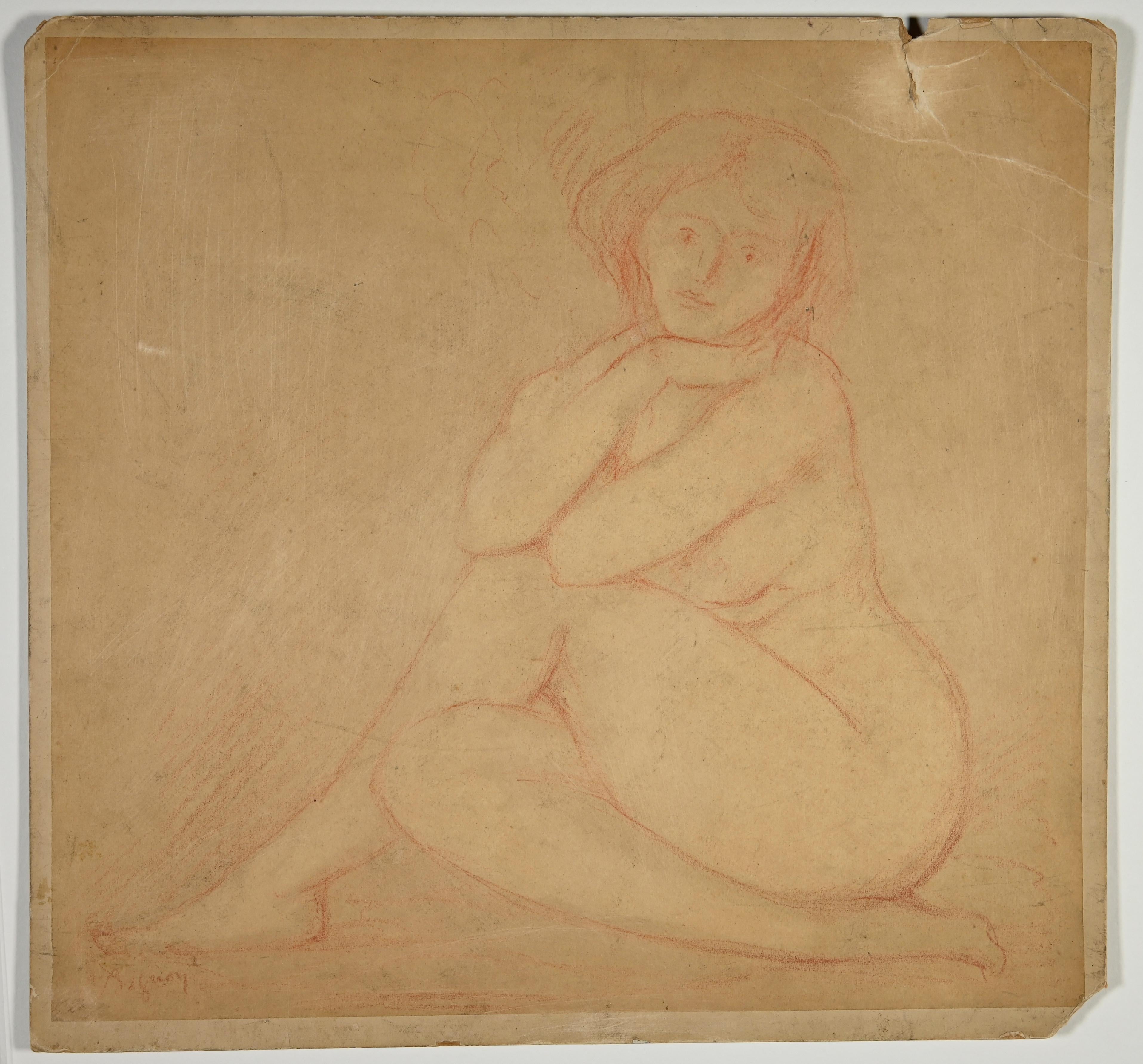Items Similar to Arm
Want more images or videos?
Request additional images or videos from the seller
1 of 8
Frantisek KupkaArmUnknown
Unknown
About the Item
Pastel on paper
13 x 19 in. (33 x 48.2 cm.)
Signed (at lower right): Kupka
EX COLL.: private collection, St. Louis; to Howard Baer, 1972; [Gimpel-Weitzenhoffer Galleries,
New York, 1972]; to B. C. Holland, until 1979; to The Museum of Modern Art, New York, until 1987
The Czech-born artist, Frantisek Kupka, studied art at the Prague Academy of Fine Arts from 1886
to 1889. In 1891, he moved to Vienna, and in 1895 he established himself as an artist in Paris.
Kupka, whose aesthetics were shaped by early on by German philosophy and symbolist painting,
remained on the periphery of the Parisian avant-garde. He steadfastly rejected any association with any artistic school or trend, although his bold use of color, particularly in delineating form and
volume, allied him with Matisse and the Fauvists.
Kupka was deeply interested in mysticism, and he spent his life in search of a transcendental “fourth dimension.” In search of forms from this alternate reality, Kupka became one of the first non-objective painters. The brilliant blue-lavender color that emanates from and envelops the form of the arm in the present pastel study represents the ambient energy of the cosmos that connects the human form to the rest of nature.
- Creator:Frantisek Kupka (1871 - 1957, Czech)
- Creation Year:Unknown
- Dimensions:Height: 13 in (33.02 cm)Width: 19 in (48.26 cm)
- Medium:
- Period:
- Condition:
- Gallery Location:New York, NY
- Reference Number:
About the Seller
5.0
Recognized Seller
These prestigious sellers are industry leaders and represent the highest echelon for item quality and design.
Established in 1952
1stDibs seller since 2010
32 sales on 1stDibs
Associations
Art Dealers Association of America
- ShippingRetrieving quote...Ships From: New York, NY
- Return PolicyThis item cannot be returned.
More From This SellerView All
- "JOHN, CLIDESDALE" / "LEVATHAN AND COPPER BOTTOM" [275/276]By James Edward Deeds Jr.Located in New York, NYGraphite and crayon on ledger paper.Category
20th Century Figurative Drawings and Watercolors
MaterialsCrayon, Graphite
- "ENDIA STEAMER / "SANTAFEE. LADY" [42/43]By James Edward Deeds Jr.Located in New York, NYGraphite and crayon on ledger paper.Category
20th Century Figurative Drawings and Watercolors
MaterialsCrayon, Graphite
- "WALK, RACK" (COPPER BOTTOM) / "TALK. ABOUT. NONSINCE, BRIMMER" [277/By James Edward Deeds Jr.Located in New York, NYGraphite and crayon on ledger paper.Category
20th Century Figurative Drawings and Watercolors
MaterialsCrayon, Graphite
- "MISS. MARTIN"/ "GRAY. EAGLE" [64/65]By James Edward Deeds Jr.Located in New York, NYGraphite and crayon on ledger paper.Category
20th Century Figurative Drawings and Watercolors
MaterialsCrayon, Graphite
- "DIXEY ARKTECTURE"/ Steamer Ship [175/176]By James Edward Deeds Jr.Located in New York, NYGraphite and crayon on ledger paper.Category
20th Century Figurative Drawings and Watercolors
MaterialsCrayon, Graphite
- "FINE FARM STOCK" / "BRIMMER" [269/270]By James Edward Deeds Jr.Located in New York, NYGraphite and crayon on ledger paper.Category
20th Century Figurative Drawings and Watercolors
MaterialsCrayon, Graphite
You May Also Like
- La femme préhistorique (Prehistoric Woman)By James Jacques Joseph TissotLocated in New Orleans, LAJames Tissot was among the most successful and critically acclaimed artists of the Victorian era. Although the artist is celebrated for his elegant scenes of fashionable life in Paris and London, this work is a fascinating rarity within his oeuvre. In this monumental pastel, Tissot depicts a prehistoric woman draped in a tiger skin, presented with a striking pose and heroic air. His delicate portraiture, combined with his fascination with conveying texture, demonstrates why he was one of the most revered artists of his generation, and La femme préhistorique illustrates the remarkable technique for which he was renowned. This work was completed in preparation for a series of works exploring the Old Testament undertaken by Tissot from 1899-1902 that remained unfinished at the time of his death. A portion of this series focused on illustrations of Adam and Eve, and among these sketches were images of a nude Eve partially draped in animal furs. Towards the end of his life, following his conversion to Catholicism, biblical subjects became important to the artist. A few years before this work was completed, Tissot embarked upon a highly ambitious group of nearly 300 watercolors illustrating the New Testament, presenting the illustrated epic in its entirety at the Paris Salon of 1894. Both of these series were a critical artistic departure for the artist, stemming from a desire to create works separated from his typical images of modern society. This pastel imagines Eve as the prototype of womanhood in the guise of a prehistoric woman. Tissot rarely painted the nude, and his skill as a draftsman highlights the figure's natural beauty, contrasting it with the stark landscape surrounding her. Although a study, this monumental work is incredibly well-finished and highly engaging, with the statuesque model commanding the majority of the canvas. Her pose is strong and theatrical, and she addresses the viewer with a direct, confident gaze. The imagined historical subject of this drawing is grounded by Tissot’s exceptional attention to detail. A master of conjuring an array of textures, Tissot showcased this ability in this work by juxtaposing many types of fabrics and natural elements within one composition. The tiger skin with which the woman partially covers herself was a favorite studio prop of Tissot’s, appearing in many of his most influential works from the period, including several paintings of his partner and favorite model Kathleen Newton. It, in particular, showcases the artist’s understanding of texture, yet it also serves as an exotic element that elevates the sensuality of the scene when placed against the woman’s bare skin. Born in 1836 in the port town of Nantes, Tissot traveled to Paris at the age of 20 in order to join the studios of Hippolyte Flandrin and Louis Lamothe. During this period, he became close with James Abbott McNeill Whistler, Edgar Degas and Edouard Manet, and the impact of these friendships is reflected in his portraits of modern life. Having enjoyed considerable success in Paris during the 1860s, Tissot fought in the Siege of Paris, and after the fall of the Commune in 1871, he went to London, where he stayed for the next ten years. He was met with incredible success there, and he also met the love of his life, Kathleen Newton, a divorcée, with whom he lived from about 1876 until her death in 1882. Today he is regarded among the great masters of Belle Époque painting, and his works can be found in important collections worldwide, including the Metropolitan Museum of Art, the Brooklyn Museum, the National Gallery of Art, the Musée d’Orsay, the Tate Gallery and many others. This pastel remained in Tissot's private collection until his death in 1902 and is referenced in the posthumous 1902-3 valuation of Tissot's home at 64 avenue du Bois...Category
Early 20th Century Academic Nude Drawings and Watercolors
MaterialsLaid Paper, Canvas, Oil Pastel, Pastel
- Don't wake up the princess - XX Century, Mixed Media Figurative Painting, NudeBy Katarzyna WazykLocated in Warsaw, PLGabryela Wasowicz is a Polish painter born in 1947. She studied at the Academy of Fine Arts of Warsaw and then at the Gerrit Rietveld Akademie in Amsterdam. Once she graduated in 197...Category
1980s Contemporary Nude Drawings and Watercolors
MaterialsPaper, Pastel, Watercolor, Gouache
- Two Balinese Beauties (Mapeed), circa 1945By Johan Rudolf BonnetLocated in Amsterdam, NLRudolf Bonnet (1895-1978) 'Mepèèd' (Mapeed) Signed lower right Titled upper right Pastel on gouache pigmented paper, 57 x 34 cm In original carved ebo...Category
1940s Nude Drawings and Watercolors
MaterialsCrayon, Paper, Pastel, Gouache, Pencil
- French Mid Century Picasso Influenced Zoomorphic Female NudeLocated in Cotignac, FRFrench Mid Century Picasso Influenced stylised zoomorphic female nude drawing, oil crayon on paper, Paris School, signed and dated 1963. The work is presented in a chrome period fram...Category
1960s Modern Nude Drawings and Watercolors
MaterialsOil Crayon, Paper, Pastel
- Nude of Woman - Drawing by Emile André Leroy - 1930sLocated in Roma, ITNude of Woman is an artwok realized by the French Artist Emile André Leroy. Pastel Drawing on paper. Hand Signed in the left margin. Good conditions except fo a small tear in the r...Category
1930s Modern Nude Drawings and Watercolors
MaterialsPaper, Pastel
- Nude of Woman - Pastel Drawing - Late 19th CenturyLocated in Roma, ITNude of Woman is an original pastels drawing on paper realized in the late 19th Century. In very good conditions. Image Dimensions: 25 x 20.5 cm Not signed.Category
1850s Modern Figurative Drawings and Watercolors
MaterialsPaper, Pastel
Recently Viewed
View AllMore Ways To Browse
Vintage Arm
C Dutch
Blue Arm
German School Unknown Artist
Prague Czech Painting
Dutch Pastel
19c Figurative Painting
Lavender Pastel
Lavender Modern Painting
13 X 19 Watercolor
Louis And Lavender
Vintage Lavender Drawing
Vintage Coll
Pastel Symbolist
19 C Dutch Paintings
Kupka Frantisek
Framed Watercolor Art
Watercolor Framed





